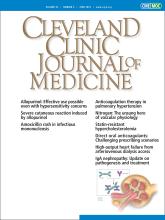Article Figures & Data
Tables
WHO classification Etiology Group I: pulmonary arterial hypertension Idiopathic; drug- or toxin-related; associated with connective tissue disease, human immunodeficiency virus infection, portal hypertension, congenital heart disease, schistosomiasis; persistent pulmonary hypertension of the newborn; pulmonary arterial hypertension with venous or capillary involvement Group II: pulmonary hypertension associated with left heart disease Heart failure, valvular heart disease, congenital or acquired heart conditions leading to postcapillary pulmonary hypertension Group III: pulmonary hypertension associated with lung disease, hypoxia, or both Obstructive lung disease or emphysema, restrictive lung disease, lung disease with mixed pattern, hypoventilation syndromes, hypoxia without lung disease, developmental lung disease Group IV: pulmonary hypertension associated with pulmonary artery obstruction Chronic thromboembolic pulmonary hypertension, other pulmonary artery obstructions (malignant tumors, sarcomas) Group V: pulmonary hypertension with unclear or multifactorial mechanisms Hematologic disorders, systemic disorders, metabolic disorders, chronic renal failure with or without dialysis, fibrosing mediastinitis, pulmonary tumor thrombotic microangiopathy Based on information from reference 1.
Study, design, population Outcomes Results Comments and limitations Rich et al (1992)9
Prospective post hoc cohort analysis of 64 patients with PAH5-year survival Improved survival in the 35 patients who received VKA VKA started if lung perfusion scan was abnormal Ngian et al (2012)10
Prospective multicenter cohort of 117 patients with incident CTD-PAH3-year survival Improved survival in patients with CTD-PAH who received VKA Lack of information on length of therapy and presence of concomitant venous thromboembolism or atrial fibrillation Johnson et al (2012)11
Retrospective cohort study of 66 patients with idiopathic PAH and 98 patients with SSc-PAH3-year survival
Time from PAH diagnosis until death from all causes
Probability that VKA improved median survival by ≥ 6 monthsVKA showed low probability for improving survivability in idiopathic PAH and SSc-PAH Small study size
Included all patients exposed to VKA regardless of minimum duration or dosing
Didn’t include all prognostic factors for survival of patients with PAHCOMPERA (2014)2
Prospective post hoc cohort analysis of 1,283 patients with PAH (800 idiopathic, 208 SSc-PAH)3-year survival Improved survival in patients with idiopathic PAH who mainly received VKA, but not in other forms of PAH Lack of information on length of therapy and presence of concomitant venous thromboembolism or atrial fibrillation REVEAL (2015)4
Prospective post hoc cohort analysis of 144 patients with idiopathic PAH and 43 with SSc-PAH who received VKA anytime during study, matched with 187 who did not3-year survival Similar survival between 2 groups
Lower survival in patients with SSc-PAH who had taken VKALack of information on length of therapy and presence of concomitant venous thromboembolism or atrial fibrillation
Mix of prevalent and incident casesHEMA-HTP (ongoing)12
Prospective multicenter cohort of 203 patients (88 PAH, 115 chronic thromboembolic pulmonary hypertension); 152 on VKA, 51 on direct oral anticoagulants, 4 on combined antiplatelet therapyMajor bleeding (International Society on Thrombosis and Haemostasis definition) Preliminary results showed significant bleeding risk, with 22 patients experiencing major bleeding (12 with PAH, 10 with chronic thromboembolic pulmonary hypertension)
Two patients died from major bleedingKhan et al (2018)6
Systematic review and meta-analysis of 12 studies (8 retrospective, 4 prospective); 2,512 patients (1,342 on anticoagulation; 1,170 controls)Impact of adjunctive oral anticoagulants in PAH and whether response differed by PAH subtype Anticoagulation significantly reduced mortality in overall PAH group—reduction most significant in idiopathic PAH, with no difference in CTD-PAH
Increased mortality seen in patients with SSc-PAH on anticoagulation therapyAbsence of randomized clinical trials
Heterogeneity of results, possibly secondary to various concomitant therapies
Possibility of publication biasWang et al (2020)8
Systematic review and meta-analysis of 8 observational studies (1,812 patients with idiopathic PAH)Efficacy of anticoagulation therapy in idiopathic PAH No significant difference in survivability in treated vs untreated patients with idiopathic PAH Absence of randomized clinical trials
Definitions and patient inclusion criteria differed between the 8 studies, leading to bias
Unbalanced patient characteristicsCOMPERA = Comparative, Prospective Registry of Newly Initiated Therapies for Pulmonary Hypertension; CTD = connective tissue disease; HEMA-HTP = Bleeding Frequency Under Anticoagulant Treatment in Pulmonary Hypertension; PAH = pulmonary arterial hypertension; REVEAL = Registry to Evaluate Early and Long-Term PAH Disease Management; SSc = systemic sclerosis; VKA = vitamin K antagonist






